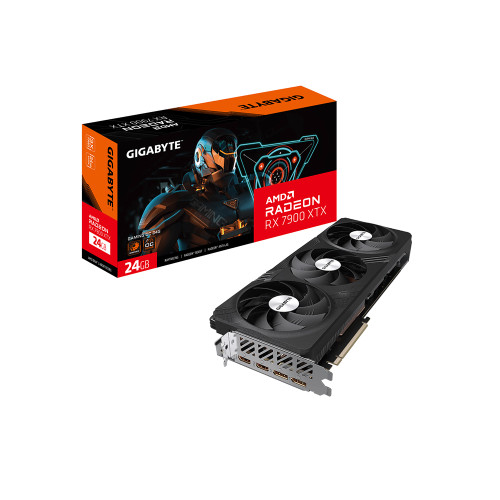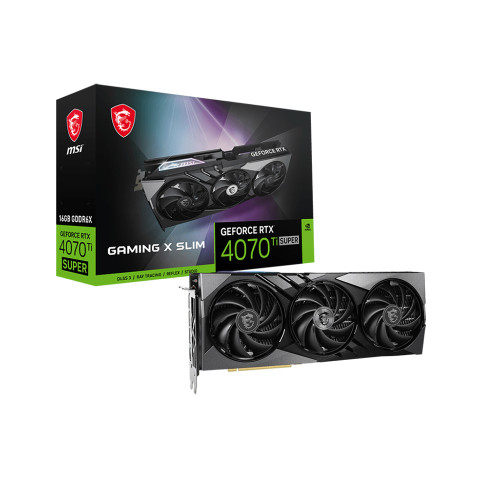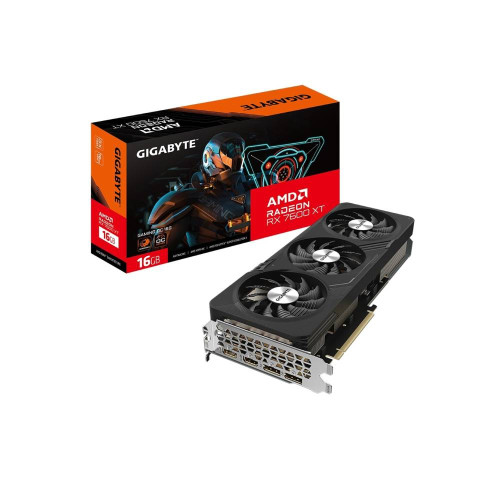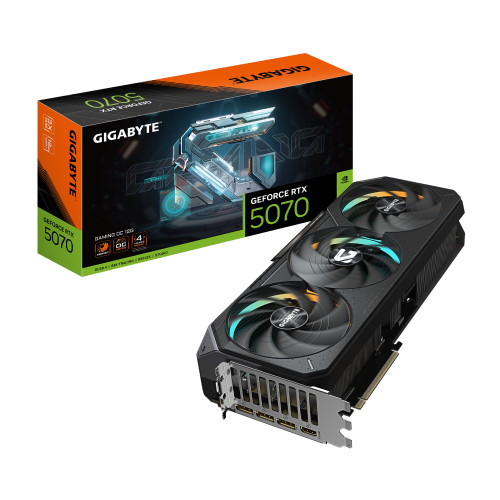POSTED: 04 April, 2025
What Are the Best Graphics Cards for 1080p and 1440p Gaming
Do you want to play 1080p and 1440p gaming but do not know which are the best graphics cards for them? Well, we've got you covered.
Generation after generation, graphics cards are pushed to deliver better image quality. Look at any two high-end games released just a few years apart — the difference in detail, lighting, and realism is stunning. However, while visual fidelity keeps improving, two things haven't changed: 1080p and 1440p are still the most popular resolutions among PC gamers. These are the baseline for competitive players chasing high frame rates and are far more forgiving on your hardware than 4K.
That said, not all GPUs are built the same — and you still need the right card to play the latest titles smoothly. Even at 1080p, modern games demand more power than ever. And if you're gaming at 1440p? You'll want something that can keep up without costing the earth. In this guide, we'll break down the best GPUs for both resolutions — including the newest launches from NVIDIA's 50 Series and AMD's latest offerings— and help you choose the right one for your build in 2025.
AMD Radeon RX 7900 XTX: Best Overall Value AMD Graphics Card
Key Features
- 24 GB GDDR6 Memory
- Radeon RX 7900 XTX Graphics
- 7680 x 4320 Max. Resolution
- 3 x DisplayPort 2.1, 1 x HDMI 2.1
- Speed: 20 Gbps
- Triple Fan
- Black Colour
The AMD Radeon RX 7900 XTX stands out as one of the best graphics cards in 2025 — especially for those gaming at 1440p or considering the occasional leap to 4K. While 1080p remains the most common resolution among PC gamers, and 1440p continues to grow in popularity as the visual sweet spot, this card handles both effortlessly. It's built with a massive 24GB of GDDR6 memory running at 20Gbps across a 384-bit interface — far more than you need for 1080p, but perfect for future-proofing if you plan to push graphical settings or dive into more demanding titles down the line.
In real-world gaming, the RX 7900 XTX chews through 1440p workloads without flinching, delivering ultra settings at consistently high frame rates. Thanks to support for DisplayPort 2.1 and HDMI 2.1, it's also ready for more advanced setups, meaning high-refresh 4K monitors and ultrawide are fully in play.
The triple-fan cooler keeps things running cool and quiet, while the 2 x 8-pin PCIe power connectors mean you won't need to overhaul your PSU to run it. With a clean black finish and a length of 338mm, it fits most modern cases with a bit of planning. AMD Radeon RX 7900 XTX is also surprisingly efficient when considering how much performance it delivers. Whether you're targeting a buttery-smooth 1440p 165Hz experience or just want a no-compromise graphics card for PC gaming at 1080p with longevity baked in, the RX 7900 XTX is hard to beat.
NVIDIA GeForce RTX 4070 Ti SUPER: Best Overall Value NVIDIA Graphics Card
Key Features
- 16 GB GDDR6X Memory
- NVIDIA GeForce RTX 4070 Ti SUPER Graphics
- 7680 x 4320 Max. Resolution
- Speed: 21000 MHz
- 3 Fan
- White Colour
If you're leaning toward NVIDIA for your next GPU upgrade and want something with serious power for 1440p gaming, the GeForce RTX 4070 Ti SUPER is a well-rounded option. Built on NVIDIA's Ada Lovelace architecture and packing 16GB of super-fast GDDR6X memory, this card hits the performance sweet spot for high-refresh 1440p gaming while still being very capable at 1080p if you're chasing ultra-high frame rates.
It's designed for gamers who want speed and style — the slim white aesthetic is a standout if you're going for a clean, custom look. With a boost clock reaching up to 21,000 MHz and a 256-bit memory interface, it easily handles modern AAA titles, even with ray tracing enabled. Whether playing Cyberpunk 2077 at 1440p ultra or flying through high-FPS esports titles like Apex Legends or Warzone, the 4070 Ti SUPER delivers consistent performance without thermal throttling, thanks to its efficient triple-fan cooling setup.
GeForce RTX 4070 Ti SUPER runs via a single 16-pin PCIe power connector and fits snugly in most mid-sized cases at just over 300mm long — ideal for gamers who want the best GPU for 1080p 144hz and 1440p performance without the bulk of chips like the 4090 graphics card. It supports NVIDIA Experience with G-SYNC for tear-free gameplay, maxes out at 7680 x 4320 resolution (if you're future-proofing), and comes backed with a 3-year warranty for peace of mind. While it's technically part of the 40 Series, the "SUPER" refresh gives it a welcome performance bump that puts it right in the conversation for anyone comparing next-gen-ready cards.
Check out our NVIDIA graphics cards UK range to shop the best one for you.
AMD Radeon RX 7600 XT: Best AMD Graphics Card for High-Refresh 1080p Gaming
Key Features
- 16 GB GDDR6 Memory
- Clock: 2539 MHz | OC Clock: 2810 MHz OC mode
- Radeon RX 7600 XT Graphics
- 7680 x 4320 Max. Resolution
- 2 x DisplayPort 2.1, 2 x HDMI 2.1
- Speed: 18 Gbps
- Triple Fan
- Black Colour
If your goal is to build a system that's fast, efficient, and focused purely on responsiveness and fluid gameplay, AMD Radeon RX 7600 XT deserves a serious look. Based on AMD RDNA 3 architecture, this AMD GPU punches well above its weight when it comes to pushing frame rates in popular titles like Valorant, CS2, or Overwatch 2 — the kind of games where every millisecond counts. Thanks to generous 16GB of GDDR6 memory and a max boost clock of up to 2810 MHz in OC mode, the RX 7600 XT handles gaming like a breeze, even when you're cranking up the settings. It's ideal for players running 144Hz or 165Hz monitors, offering the smooth, stutter-free experience critical in competitive play.
The triple-fan cooling keeps thermals under control even during extended sessions, and its compact 281mm design means it'll fit nicely into a range of mid-size or smaller cases. Display support is rock solid, too — with 2 x DisplayPort 2.1 and 2 x HDMI 2.1 outputs, it can comfortably handle a four-monitor setup or feed into a high-refresh main screen and a secondary display without compromise.
Unlike some of AMD's more power-hungry options, this card keeps things modest with 2 x 8-pin PCIe connectors and pairs well with a 600–650W PSU. It's also FreeSync-ready, letting you lock in a tear-free experience when paired with a compatible display. While it might not be the go-to card for ultra-heavy workloads or 4K gaming, the RX 7600 XT hits a perfect middle ground for players who want strong, reliable performance at 1080p and even 1440p.
Explore the best AMD graphics cards for gaming here.
AMD Radeon RX 9070: Latest AMD Graphics Card for Blazing-Fast 1440p Gaming
Key Features
- 16 GB GDDR6 Memory
- Radeon RX 9070 Graphics
- 7680 x 4320 Max. Resolution
- 3 x DisplayPort 2.1, 1 x HDMI 2.1
- Speed: 20 Gbps
- Triple Fan
- Stream Processor: 3584 Units
- Black Colour
For gamers who want a future-ready graphics card that handles modern 1440p gaming with confidence — and even dips into light 4K workloads — the AMD Radeon RX 9070 is one of the smartest mid-high tier choices this year. It comes loaded with 16GB of fast GDDR6 memory and a 256-bit memory interface, which means it can power through graphically intensive titles with stable performance and minimal compromise.
Backed by AMD's RDNA 4 architecture and featuring 3584 stream processors, the RX 9070 delivers clean, responsive gameplay at 1440p with all the visual extras switched on, including ray tracing and high-resolution texture packs. Despite its power, it remains well-behaved thermally thanks to a triple-fan cooler that balances airflow and acoustics.
At 340mm in length, it's a fairly substantial card, so it's best suited for full-size ATX cases, and it draws power via two 8-pin PCIe connectors — nothing extreme, but worth checking PSU compatibility if you're upgrading from an older setup. Display output options are generous, too, with three DisplayPort 2.1 ports and a single HDMI 2.1, giving you flexibility for multi-monitor rigs or high-refresh displays. With support for AMD FreeSync, screen tearing and stuttering are kept in check, especially when paired with a monitor in the 1440p 144Hz+ range. While it sits below the RX 9070 XT and RX 7900 cards in AMD's current lineup, the RX 9070 finds its strength in consistency, value, and sensible specs.
If you want the full story of what makes the RX 9070 such a game-changer, read our RX 9070 breakdown here.
NVIDIA GeForce RTX 5070 Ti: Next-Gen NVIDIA GPU for Gaming
Key Features
- 16 GB GDDR7 Memory
- GeForce RTX 5070 Ti Graphics
- 7680 x 4320 Max. Resolution
- 3 x DisplayPort 2.1b, 1 x HDMI 2.1b
- Speed: 28 Gbps
- Triple Fan
NVIDIA's next-gen RTX 5070 Ti – powered by Blackwell architecture, makes a bold entrance with features that signal its ambition to dominate high-performance gaming graphics cards. With 8960 CUDA cores, next-gen 5th Gen Tensor cores, and 4th Gen ray tracing performance rated at 133 TFLOPS, this card is built for gamers who expect modern titles to look and feel flawless at maxed-out visual settings.
The 16GB of ultra-fast GDDR7 memory, running at a blistering 28 Gbps, ensures lightning-quick texture loading and headroom for demanding assets — making it one of the first consumer GPUs to push this next-gen memory standard. Its PCIe 5.0 interface also helps eliminate bandwidth bottlenecks when paired with a current-gen motherboard, while a clean triple-fan cooler keeps everything cool under sustained load.
Despite all that power, the NVIDIA graphics card remains well-optimised for modern rigs. It draws power via a single 16-pin connector and occupies a 3.5-slot design—so check your case space before installation. Visual outputs are 3 x DisplayPort 2.1b and 1 x HDMI 2.1b, supporting resolutions up to 8K (7680 x 4320), though this card really finds its stride in the best 1440p GPU setups. Backed by NVIDIA G-SYNC for smoother frame pacing and ultra-low latency, it's a perfect pairing for QHD displays in the 165Hz–240Hz range.
Learn more about NVIDIA's latest RTX 50 Series features here.
What Do You Really Need to Game at 1440p?
1440p gaming hits a sweet spot. It's visually sharper than 1080p but not nearly as punishing on hardware as 4K. That said, it still requires a well-optimised setup to run smoothly, especially if you're aiming for high frame rates.
Here are the things you need to look for to play games at 1440p resolution.
- A modern GPU with 12GB to 16GB of VRAM.
- Look for faster memory types like GDDR6X or GDDR7, and a 256-bit memory interface or higher.
- GPUs such as the RTX 4070 Ti SUPER, RX 7800 XT, RTX 5070 Ti or similar range.
- Aim for a 6-core or 8-core processor from the latest AMD Ryzen or Intel Core generation.
- 16GB of DDR4 or DDR5 RAM running at 3200MHz or faster is recommended.
- A 2TB NVMe SSD for improved load times
- Ensure your power supply is up to the task; 650W to 850W is typically required for 1440p-class GPUs.
- A 144Hz or higher refresh rate monitor that supports G-SYNC or FreeSync.
What Do You Really Need to Game at 1080p?
1080p gaming is still the go-to standard for many players, especially those who prioritise high frame rates and competitive performance over raw visual fidelity. It's far less demanding than higher resolutions, which makes it perfect for budget builds or esports setups.
- Here's what you should look for to game comfortably at 1080p:
- A mid-range GPU with at least 8GB of VRAM.
- A solid quad-core or 6-core CPU by Intel or AMD.
- 16GB of RAM at 3000MHz or higher t keep everything running smoothly.
- A 500GB NVMe SSD is workable, but 1TB is safer with today's game sizes.
- Depending on your GPU, a 550W to 650W power supply will usually be sufficient.
- Most 1080p GPUs run cool, but ensure your case has decent airflow.
- To get the most out of your setup, pair it with a 1080p 144Hz monitor.
- FreeSync or G-SYNC support is well worth having, even at this resolution.
Conclusion
With the best graphics cards from AMD and NVIDIA now available, there's never been a better time to upgrade or build a gaming PC for 1080p or 1440p. These resolutions continue to dominate because they offer brilliant performance and visual fidelity without demanding top-tier hardware or top-shelf prices.
But the truth is, resolution alone doesn't tell the whole story. A smooth, stable gaming experience depends on picking a GPU that's tailored to how you play. If you're chasing every frame in competitive shooters, a high-refresh 1080p setup with a card like the RX 7600 XT makes perfect sense. If you prefer cinematic visuals at 1440p, with ultra settings and ray tracing in the mix, something like the RTX 4070 Ti SUPER or RX 7900 XTX will give you exactly that and hold up for years to come.
What matters in 2025 is just how far the mid-range has come. Cards like the RX 9070 and RTX 5070 Ti now deliver performance that would've been considered high-end just a generation ago. That means more choice, value, and flexibility to build around your needs.
Ready to upgrade your gaming experience?
Explore the full range of AMD and NVIDIA graphics cards at Box.co.uk and find the perfect fit for your 1080p or 1440p setup. Whether you're chasing high frame rates or ultra detail, we've got the GPU to power your play.
Shop Graphics Cards Now




